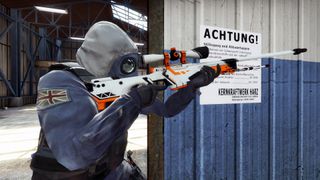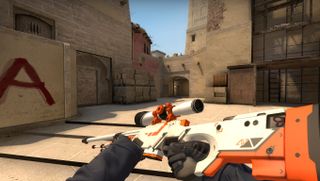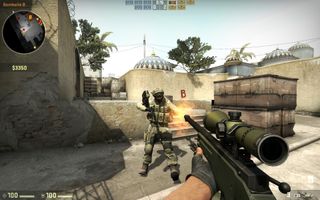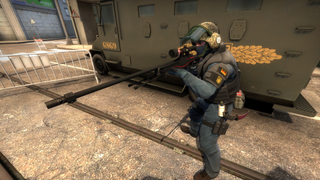How to AWP: mastering Counter-Strike's iconic rifle

Tennis players know the peculiar feeling of zenlike calm and control that comes with starting a serve. Suddenly, all worries about footwork, planning drop shots, and recovering from an opponent’s serve dissipate: the pace of the game rests in the palm of your hand.
Wielding Counter-Strike’s deadliest gun is a little like that. Like a great tennis player, talented AWPers have a mixture of patience and confidence. They tap into a slow mindset and lightning reflexes simultaneously.
The AWP is an intimidator, both when it’s pointed at you and when you’re learning the weapon. Carrying an AWP isn’t simply an equipment decision, but a discipline in and of itself with its own set of techniques, guidelines, and pitfalls.

The basics of the AWP
The AWP is heavy, powerful, and expensive. Its reputation arises from the fact that, in a game about eliminating other players from the round, it’s the only weapon that can kill someone with one body shot. However, it isn’t a one-hit kill in all circumstances, as leg and lower groin shots deal 85 damage (aka “legging”), as do shots that clip through surfaces such as railings or corners.
With the AWP’s great power comes equal responsibility. Whether in a 5-on-5 competitive game or in casual mode, you’ll put down $4,750 to buy an AWP. If that investment doesn’t pay off (or worse, if an opponent kills you and steals it), it can break your team’s economy for rounds to come. Other than the autosniper (aka the G3SG1/SCAR-20), the same can’t be said for other investments in CS:GO.
Certain aspects of the AWP make it unwieldy to the newcomer, including its effect on mobility. A player running with the knife moves at 250 units per second; with a USP-S, 240 units per second; with the AK-47, 215; with the AWP, a mere 200 units per second—20 percent slower than with a knife. Only the light machine guns, the Negev and the M249 (195 units), are slower.
The AWP’s firerate is equally slow, placing huge importance on hitting your first shot. The Scout, the AWP’s cheaper sibling, features a similarly slow firerate but allows for insanely high mobility, even when scoped-in (unlike the AWP). And like many of CS:GO’s guns, the AWP is sensitive to movement, requiring near-perfect stillness to execute an accurate shot (see the Advanced Techniques section for more on this). AWPers are thus faced with the dilemma of holding static angles that easily fall prey to flashbangs and pincer-pushes onto bombsites.
The biggest gaming news, reviews and hardware deals
Keep up to date with the most important stories and the best deals, as picked by the PC Gamer team.
But the AWP has more advantages still. It boasts the best penetration in-game, both in terms of wall penetration power with a value of 250 (this value ranges from 0-300, with a higher value indicating that a bullet can penetrate harder surfaces at longer distances) but also in terms of armor penetration (97.5 out of 100 in the in-game menu, the second-highest in the game, which in effect nullifies the damage-softening effect of armor). The right combination of guesswork and timing can lead to impossible shots that defy logic.

When should I buy an AWP?
If you want to buy an AWP in a competitive game, the best time to do it is on the first gun round of the game (typically the fourth round) and when you’re carrying at least $5,750. Even if your team has lost the first three rounds, secured zero objectives, and you personally didn’t notch a kill over that time, you’ll have earned $6,500 total by round four, including your initial $800 of starter cash.
The most effective AWPer will spend even more to purchase a set of grenades, about $6,450. Here’s your shopping list for a solid buy:
- AWP - $4,750
- Kevlar & helmet - $1,000
- Two flashbangs and a smoke grenade - $700
Buy an AWP without armor, and you’re making a ‘glass cannon buy.’ It’s an enormous risk—you’re turning yourself into a slow-moving cannon with no protection, not only to damage, but to the accuracy-disrupting effects of aim punch. Avoid AWPing without full armor except in the most desperate straits, like when your opponent is on the verge of winning the match.
If your teammate in competitive mode has bought an AWP, reconsider buying another one. There are situations where the map will dictate otherwise (double AWPing as CT on de_dust2 is viable due to its long sight lines on A, B, and mid), but the economic risk is rarely worth the potential gain. In casual mode on the other hand, buying an AWP is merely a matter of buying cheaply for a round or two to save up for Big Green.

The two styles of AWPing
Broadly, there are two situations in which you’ll use an AWP: covering an angle while stationary (passive AWPing), or while roaming (aggressive AWPing). In the professional CS:GO scene, players like Titan’s SmithZz and the Danish player nico (who was recently replaced on Dignitas) fit into the passive style, while EnVyUs’ kennyS or Fnatic’s JW tend to play aggressively.
Passive AWPing best works at corners where you have the option of retreating behind solid cover, where you can protect yourself until the AWP is ready to fire again (e.g. the box at the back corner of B site on de_dust2). Passive players only have to worry about one angle, avoiding getting flashed or smoked out of their roost, and hitting the shot.
Passive AWPers are also the ones who have to worry the most about the maximum zoom setting when scoped-in. The AWP features two zoom settings which right clicking cycles through: one further out and a magnified one.
As a rule of thumb to the young AWP initiate, use the single-zoom setting in all of your duels. A passive AWPer holding a long position such as from bombsite A towards pit on de_dust2 should consider using the maximum zoom setting to increase chances of hitting a distant, protected target. AWPers planning on holding close angles or playing with mobility should avoid the maximum zoom setting in almost all circumstances, as it inhibits reaction to unexpected threats.
Aggressive AWPers have a much more complex portfolio to work with in terms of using the gun. For them, techniques such as walking while scoped in and searching for enemies have no place, as the maximum field of vision and information is required in order to hit lightning-fast shots. These players rely on advanced techniques of AWPing.
Most Popular

